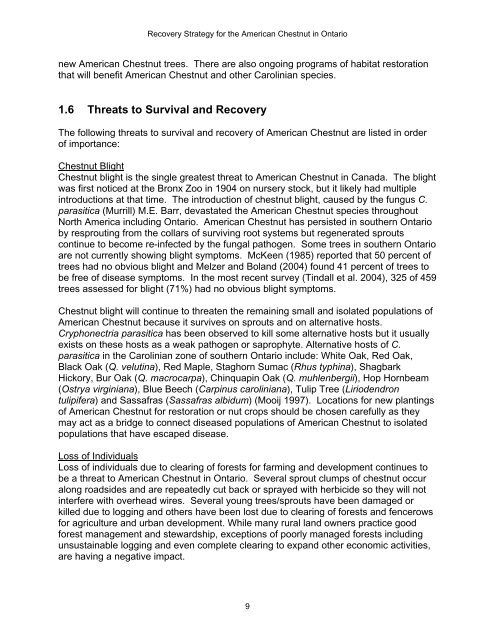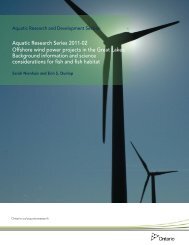(Castanea dentata) in Ontario - Ministry of Natural Resources ...
(Castanea dentata) in Ontario - Ministry of Natural Resources ...
(Castanea dentata) in Ontario - Ministry of Natural Resources ...
You also want an ePaper? Increase the reach of your titles
YUMPU automatically turns print PDFs into web optimized ePapers that Google loves.
Recovery Strategy for the American Chestnut <strong>in</strong> <strong>Ontario</strong><br />
new American Chestnut trees. There are also ongo<strong>in</strong>g programs <strong>of</strong> habitat restoration<br />
that will benefit American Chestnut and other Carol<strong>in</strong>ian species.<br />
1.6 Threats to Survival and Recovery<br />
The follow<strong>in</strong>g threats to survival and recovery <strong>of</strong> American Chestnut are listed <strong>in</strong> order<br />
<strong>of</strong> importance:<br />
Chestnut Blight<br />
Chestnut blight is the s<strong>in</strong>gle greatest threat to American Chestnut <strong>in</strong> Canada. The blight<br />
was first noticed at the Bronx Zoo <strong>in</strong> 1904 on nursery stock, but it likely had multiple<br />
<strong>in</strong>troductions at that time. The <strong>in</strong>troduction <strong>of</strong> chestnut blight, caused by the fungus C.<br />
parasitica (Murrill) M.E. Barr, devastated the American Chestnut species throughout<br />
North America <strong>in</strong>clud<strong>in</strong>g <strong>Ontario</strong>. American Chestnut has persisted <strong>in</strong> southern <strong>Ontario</strong><br />
by resprout<strong>in</strong>g from the collars <strong>of</strong> surviv<strong>in</strong>g root systems but regenerated sprouts<br />
cont<strong>in</strong>ue to become re-<strong>in</strong>fected by the fungal pathogen. Some trees <strong>in</strong> southern <strong>Ontario</strong><br />
are not currently show<strong>in</strong>g blight symptoms. McKeen (1985) reported that 50 percent <strong>of</strong><br />
trees had no obvious blight and Melzer and Boland (2004) found 41 percent <strong>of</strong> trees to<br />
be free <strong>of</strong> disease symptoms. In the most recent survey (T<strong>in</strong>dall et al. 2004), 325 <strong>of</strong> 459<br />
trees assessed for blight (71%) had no obvious blight symptoms.<br />
Chestnut blight will cont<strong>in</strong>ue to threaten the rema<strong>in</strong><strong>in</strong>g small and isolated populations <strong>of</strong><br />
American Chestnut because it survives on sprouts and on alternative hosts.<br />
Cryphonectria parasitica has been observed to kill some alternative hosts but it usually<br />
exists on these hosts as a weak pathogen or saprophyte. Alternative hosts <strong>of</strong> C.<br />
parasitica <strong>in</strong> the Carol<strong>in</strong>ian zone <strong>of</strong> southern <strong>Ontario</strong> <strong>in</strong>clude: White Oak, Red Oak,<br />
Black Oak (Q. velut<strong>in</strong>a), Red Maple, Staghorn Sumac (Rhus typh<strong>in</strong>a), Shagbark<br />
Hickory, Bur Oak (Q. macrocarpa), Ch<strong>in</strong>quap<strong>in</strong> Oak (Q. muhlenbergii), Hop Hornbeam<br />
(Ostrya virg<strong>in</strong>iana), Blue Beech (Carp<strong>in</strong>us carol<strong>in</strong>iana), Tulip Tree (Liriodendron<br />
tulipifera) and Sassafras (Sassafras albidum) (Mooij 1997). Locations for new plant<strong>in</strong>gs<br />
<strong>of</strong> American Chestnut for restoration or nut crops should be chosen carefully as they<br />
may act as a bridge to connect diseased populations <strong>of</strong> American Chestnut to isolated<br />
populations that have escaped disease.<br />
Loss <strong>of</strong> Individuals<br />
Loss <strong>of</strong> <strong>in</strong>dividuals due to clear<strong>in</strong>g <strong>of</strong> forests for farm<strong>in</strong>g and development cont<strong>in</strong>ues to<br />
be a threat to American Chestnut <strong>in</strong> <strong>Ontario</strong>. Several sprout clumps <strong>of</strong> chestnut occur<br />
along roadsides and are repeatedly cut back or sprayed with herbicide so they will not<br />
<strong>in</strong>terfere with overhead wires. Several young trees/sprouts have been damaged or<br />
killed due to logg<strong>in</strong>g and others have been lost due to clear<strong>in</strong>g <strong>of</strong> forests and fencerows<br />
for agriculture and urban development. While many rural land owners practice good<br />
forest management and stewardship, exceptions <strong>of</strong> poorly managed forests <strong>in</strong>clud<strong>in</strong>g<br />
unsusta<strong>in</strong>able logg<strong>in</strong>g and even complete clear<strong>in</strong>g to expand other economic activities,<br />
are hav<strong>in</strong>g a negative impact.<br />
9
















